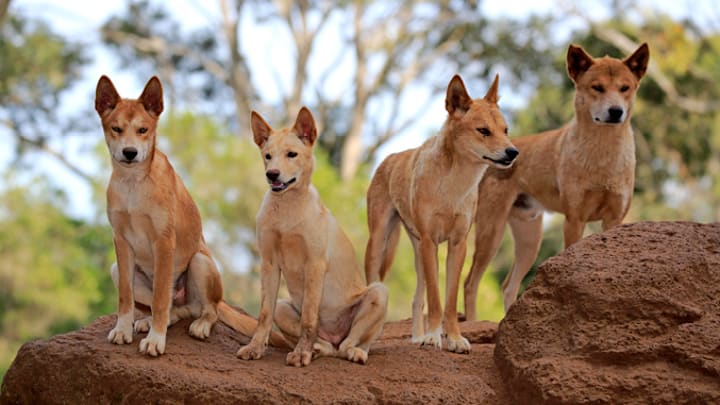When people hear the word dingo, they likely think of the famous movie (and Seinfeld) line, “a dingo ate my baby.” While the phrase was inspired by true events, there’s a lot more to learn about the Australian canines than their baby-snatching reputations would suggest.
- The dingo is not a dog breed.
- Some consider dingoes pests.
- The largest fence in the world was built to keep dingoes away from livestock.
- There are different populations of dingo.
- People keep them as pets.
- It’s illegal to keep them as pets in a few Australian states.
- Dingo ancestry shows up in domesticated dogs (and vice versa).
- Dingoes can turn their heads about 180 degrees.
- Their flexible wrists help them catch prey.
- Dingoes don’t really bark.
- Dingoes live a long time in zoos.
The dingo is not a dog breed.
Technically, dingoes are not a breed of dog. They’re only semi-domesticated and are just as much wolf as they are dog. So far, it’s unclear if Canis lupus dingo was ever fully domesticated. Some evidence suggests that they may once have been pets, but were abandoned and left to revert to their wild state. It’s believed that travelers from Indonesia or Southeast Asia dropped the once-domesticated dogs in Australia roughly 4000 years ago. The dogs, left to their own devices, thrived by falling back on the wolfish instincts of their ancestors. While some dingoes would travel and eat with Aboriginal tribes on the Australian continent, they were wary companions and certainly not pets.
Some consider dingoes pests.
Left to fend for themselves, dingoes became the largest terrestrial predator in Australia and enjoyed a wide variety of prey to gobble down. It wasn't until the English colonized to the country and brought their sheep that the dingo ran into trouble. Dingoes feasted on the newcomers’ livestock until the farmers were at their wit’s end. While most dogs are considered humans’ best friend, Australian farmers have considered dingoes an enemy.
The largest fence in the world was built to keep dingoes away from livestock.
Australians desperate to keep their flocks safe resorted to building a fence in southeastern Australia to keep the dingoes out. The impressive fence is one of the longest structures in the world and is generally considered the longest fence. The original incarnation was a collection of small fences built in the 1880s to prevent the spread of rabbit plague, but they fell into disrepair. In the early 1900s, they were repaired and converted into dingo fences. The various structures were connected in the 1940s to create one giant, continuous fence. It once stretched 8614 kilometers (5352.5 miles) long, but has since been shortened to 5614 kilometers (3488.4 miles). It costs 10 million Australian dollars a year in upkeep, but is considered mostly a success at keeping the predators out.
There are different populations of dingo.
The range of climates across Australia likely led to the development of different ecotypes of dingo, which all reside in different areas of the continent. Desert dingoes are reddish, golden yellow, or sand-colored with a compact body size. Alpine dingoes are the rarest in the wild and have a light cream coat. Finally, northern dingoes have a finer stature and lack the double coat the other two populations have.
People keep them as pets.
Some might frown upon keeping a semi-wild animal as a pet, but others find dingo ownership to be very rewarding. That said, the dogs are very high-maintenance. Since dingoes are closely related to wolves, they have deeply ingrained pack values. They don't like being left alone and greetings are a necessary 15-minute procedure filled with patting, talking, and kissing. Failure to properly pay attention to the dogs’ needs and pack mentality will leave the dogs disappointed and upset. Owners of dingoes will not be able to move frequently because of the dogs' dislike of change. Having a dingo as a pet is a full time responsibility, because dingoes don't handle rejection well and will likely not adjust from being placed in a new home.
It’s illegal to keep them as pets in a few Australian states.

In New South Wales and Western Australia, it's legal to own a dingo without a permit. Victoria and the Northern Territory require a special permit, but in Tasmania, Queensland, and South Australia, it is completely illegal to own the wild dogs.
Dingo ancestry shows up in domesticated dogs (and vice versa).
Despite being somewhat wild, dingoes are still dogs and have interbred with other canines in Australia. You can find dingo DNA in Australian Kelpies and Australian cattle dogs. Breeders realized that the sturdy wild dogs were perfect to help bulk up working dogs. Hybridized dingoes also exist in the wild.
Dingoes can turn their heads about 180 degrees.

Dingoes are well-equipped for the Australian Outback and have an impressive sense of vision. They can even swivel their heads about 180 degrees. Comparatively, owls can turn their heads 270 degrees.
Their flexible wrists help them catch prey.
Just like humans, dingoes have rotating wrists. This allows them to use their paws like hands to catch prey. It also helps them better climb trees and even open doors. Their flexible wrists let them climb and enter places other dogs can’t go, making them a formidable pest for farmers trying to keep them away from their livestock.
Dingoes don’t really bark.
Unlike your standard dog, dingoes are much quieter. Instead of barking, the dogs have a yodel-like howl.
Dingoes live a long time in zoos.
In the wild, dingoes live somewhere between five to 10 years, but in zoos, they can live upwards of 18 to 20 years. Most domesticated dogs don't boast such a long lifespan. Comparatively, the English springer spaniel, which is roughly the same size as the dingo, lives 10 to 14 years.
Discover More Stories About Dogs:
A version of this story was published in 2017; it has been updated for 2025.
